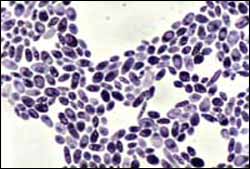Improved statistical tools reveal many linked loci

High-throughput genotyping and expression profiling of a recombinant strain of yeast. (Photo: Storey et al.)
An innovative new statistical method, described in the open-access journal PLoS Biology, streamlines the computation required to identify all the potential locations in the genome that influence a particular physical trait, or phenotype. Thanks to the new method developed by John Storey, Joshua M. Akey, and Leonid Kruglyak, researchers have a more efficient genome-mining technique to help them identify all the genomic elements that produce specific traits. In brewer’s yeast alone, Storey and colleagues found that 37% of gene expression traits link to two loci, or positions in the genome.
“We were interested in being able to find combinations of genes that affect the phenotype,” says Kruglyak. “It’s generally thought that most traits of interest have a complex underlying genetic basis, but it’s generally been pretty difficult to get at those.” Typically, researchers might be able to find only one of the genetic factors, even though more than one genetic location contributes to the observed trait, such as blood pressure or cell growth.
The new statistical method bypasses the previously overwhelming computations needed to puzzle together the myriad elements that influence gene expression throughout an entire genome. And unlike earlier approaches to understanding how multiple loci interact, the new technique can distinguish between a group of genes with a linked subset and a group of genes with “joint linkage,” where each gene site links to another.
“In some ways, it looks like you’re complicating a problem because you’re looking at thousands of genes instead of one trait,” says Kruglyak. In reality, the method creates statistical conclusions that are more precise, he explains, because you’re using so much data.
Storey et al. compared their method to another statistical method, called two-dimensional linkage analysis, which tests for linkage between all pairs of a large set of genomic marker sites. The authors found that two-dimensional analysis is not only more computationally demanding than their new method, but also generates ambiguous results because it can be difficult to distinguish whether one or both of the loci being tested are responsible for altered expression levels. This problem grows exponentially with each added test site. This approach also failed to reveal that hierarchical relationships between two genomic locations control about one in seven yeast expression traits¡Xwhich Storey et al. discovered using their method.
Although the group studied yeast, their method can be applied to more complex organisms to search for even larger numbers of linked loci and to provide insights into the many interlocking pathways that make up the gene regulatory network.
Media Contact
All latest news from the category: Life Sciences and Chemistry
Articles and reports from the Life Sciences and chemistry area deal with applied and basic research into modern biology, chemistry and human medicine.
Valuable information can be found on a range of life sciences fields including bacteriology, biochemistry, bionics, bioinformatics, biophysics, biotechnology, genetics, geobotany, human biology, marine biology, microbiology, molecular biology, cellular biology, zoology, bioinorganic chemistry, microchemistry and environmental chemistry.
Newest articles

Bringing bio-inspired robots to life
Nebraska researcher Eric Markvicka gets NSF CAREER Award to pursue manufacture of novel materials for soft robotics and stretchable electronics. Engineers are increasingly eager to develop robots that mimic the…

Bella moths use poison to attract mates
Scientists are closer to finding out how. Pyrrolizidine alkaloids are as bitter and toxic as they are hard to pronounce. They’re produced by several different types of plants and are…

AI tool creates ‘synthetic’ images of cells
…for enhanced microscopy analysis. Observing individual cells through microscopes can reveal a range of important cell biological phenomena that frequently play a role in human diseases, but the process of…





















